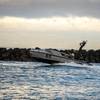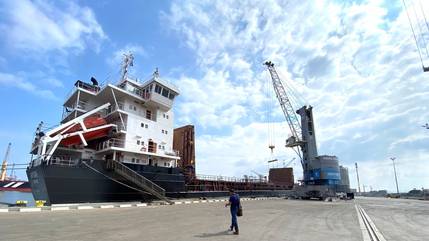House Subcommittee Hearing Highlights “Dismal State” of U.S. Icebreaking Capability
At the July 23, 2014, hearing of the House Subcommittee on Coast Guard and Maritime Transportation on “Implementing U.S. Policy in the Arctic” the committee chairman, Rep. Duncan Hunter (R-CA), opened the proceedings by holding up a graphic of the icebreaker fleets of the world—which depicts nearly 40 Russian icebreakers—and then commented on the “dismal state” of the U.S. icebreaker situation.
The hearing background paper noted that the United States presently has only two working polar class icebreakers, the 38 year-old, “heavy” icebreaker Polar Star (WAGB-10) and the 14 year-old, “medium” icebreaker Healy (WAGB-20), both of which are commissioned Coast Guard cutters. A third polar class icebreaker, Polar Sea (WAGB-11), has been, in the committee chairman’s words, “rusting away in Seattle for three years with a busted engine.” A major refurbishment completed in 2013 restored the Polar Star to active service after a 7 year layup and extended her service life for another 7-10 years (by 2023 she will be 47 years-old). Estimated design and construction time to build a replacement is 8-10 years.
Witnesses at the hearing included VADM Peter Neffenger, Vice Commandant of the Coast Guard, RADM Jonathan White, Oceanographer and Navigator of the Navy, Ambassador David Balton, Deputy Assistant Secretary for Oceans and Fisheries in the Department of State, CAPT Dave Westerholm, Director of NOAA’s Office of Response and Restoration, Dr. Kelly Falkner, Division Director for Polar Programs at the National Science Foundation, and Ed Fogels, Deputy Commissioner of Alaska’s Department of Natural Resources. No one from the maritime industry or commercial fishing was called by the subcommittee.
In their prepared written statements and opening remarks each of the first panel witnesses emphasized the importance of changing Arctic conditions and emerging uses in the Arctic and touted their agency’s steps in implementing President Obama’s National Strategy for the Arctic Region. VADM Neffenger highlighted the Coast Guard’s own Arctic Strategy and its three strategic objectives (improving awareness, modernizing governance, and broadening partnerships), its annual Arctic Shield exercises, and the newly-established Center for Arctic Strategy and Policy at the U.S. Coast Guard Academy in New London and the Arctic Coast Guard Forum—a maritime governance group formed by the eight Arctic Council member-nations and modeled after the North Pacific and North Atlantic Coast Guard Forums. Surprisingly, Neffenger testified that the Coast Guard’s two working polar class icebreakers meet the service’s short-term needs—this, despite the service’s 2011 High Latitude Region Mission Analysis Report to Congress which concluded the Coast Guard needed a minimum of 3 medium and 3 heavy polar class icebreakers to fulfill its statutory missions.
RADM White submitted a short written statement describing the Navy’s plans for “measured” steps and low-cost activities in the Arctic. Nothing in his oral remarks suggested that the Navy—which is struggling to recapitalize its own Fleet in an age of deep budget cuts and sequesters—sees the Arctic as a budget priority. Ambassador Balton described the ongoing process within the Administration to develop a program for the upcoming 2015-2017 U.S. chairmanship of the eight-member Arctic Council, under the leadership of former Coast Guard Commandant ADM Robert J. Papp Jr., who was recently appointed the U.S. Special Representative for the Arctic. Although the U.S. chairmanship “program” is still under development, Balton indicated that it will be consistent with the President’s Arctic strategy and will likely emphasize three themes: climate change, improving living conditions for Arctic residents, and responsible stewardship of the Arctic Ocean (no mention was made of maritime transportation safety and security). In response to a 2014 Government Accountability Office report (GAO 14-435) that criticized the Administration for its lack of an overall strategy to guide and prioritize federal agency participation in the Arctic Council, Balton pledged that his department has embraced all of the GAO recommendations. He also emphasized the importance of the U.S. becoming a party to the U.N. Convention on the Law of the Sea, a treaty that has been pending approval by the Senate since 1994.
CAPT Westerholm called attention to NOAA’s Arctic Vision and Strategy, Arctic Action Plan, and its annual Arctic Report Cards. He also emphasized NOAA’s weather and ice observation and forecasting services and the steps NOAA is taking to better prepare for pollution response in the Arctic. Referring to the critical need for accurate charting of Arctic waters, he testified that within the 950,000 square nautical miles of U.S. waters off Alaska, NOAA has identified areas totaling 40,000 square miles for “high priority” hydrographic surveying. However, because NOAA surveys averaged less than 500 square miles/year over the past 3 years (1,330 square miles in total), surveys of even the “highest priority” areas will take decades to complete. Dr. Falkner described the NSF’s research mission in both the Arctic and Antarctic and NSF’s need for heavy icebreaker support to meet resupply needs of U.S. Antarctic research stations. She warned the committee that we must begin planning immediately to fill that need when the Polar Star reaches the end of her service life extension. Alaska’s witness, Ed Fogels, criticized the federal government’s “heavy-handed” regulatory approach in Alaska, called for greater federal support for an Arctic deep-water port in Alaska, and then reminded the committee of the heavy and sometimes conflicting demands on Coast Guard icebreakers. In doing so, he recounted the winter 2011-2012 episode in which Coast Guard Cutter Healy was re-routed to break a channel into Nome, Alaska, to permit the Russian ice-strengthened tanker Renda to deliver critically needed fuel to the city. Fortunately for Alaskans, Admiral Papp had turned down a request earlier that winter to redeploy Healy to Antarctica, after Sweden recalled its icebreaker, the Oden, for service in the Baltic.
At the close of the first panel’s prepared remarks chairman Hunter and ranking member John Garamendi (D-CA) both questioned the depth of the agencies’ commitment to the Arctic, noting that none of the Arctic strategies have been incorporated into the agencies’ budget requests. Hunter repeatedly asked why, if icebreakers for the Arctic (and Antarctic) are so important, no one is asking to fund them. VADM Neffenger responded that other recapitalization projects are a higher priority, apparently endorsing former commandant ADM Papp’s testimony to the subcommittee in April (when Papp indicated that “the Offshore Patrol Cutter is my highest priority for the Coast Guard.”).
Many of the subcommittee’s questions, including several by Rep. Rick Larsen (D-WA), focused on the condition of the 37 year-old Polar Sea and the feasibility of repairing it for a temporary return to service. Polar Sea was deactivated more than two years ago, after a serious engine casualty. VADM Neffenger reported that the service has not even been expending the funds necessary to preserve the vessel. The Senate is considering adding $8 million to the Coast Guard’s FY 2015 budget to do the necessary preservation work, in order to “arrest” further deterioration and give the Coast Guard time to do a full assessment of what it would take to temporarily return her to active service as a bridging measure until a replacement can be designed and built. A 2012 “snapshot” estimate put the cost of restoration at approximately $100 million. Neffenger estimated that such an assessment could take two years to complete and that the cost to restore the vessel would very likely exceed the early estimate.
Rep. Mark Sanford (R-SC) asked the speakers to consider more economical alternatives to meeting U.S. requirements for Antarctic icebreaking, citing the long transit times for U.S.-based vessels to reach Antarctica. Rep. Don Young (R-AK) pushed the witnesses to give serious consideration to leasing U.S.-built icebreakers, pointing to NSF’s lease of its two ice-capable Antarctic research vessels (R/V Laurence M. Gould and R/V Nathaniel P. Palmer) as a model (a third ice-capable NSF research vessel, R/V Sikuliaq, will be home-ported in Seward, Alaska and operated by the University of Alaska-Fairbanks). VADM Neffenger responded that the Coast Guard does not see leasing as a long-term solution because there is no cost-advantage to leasing and no U.S.-built icebreakers are available for lease. It also did not appear that Rep. Young was aware of the crisis NSF faced in 2011, when Sweden withdrew their icebreaker Oden, which NSF had contracted to service the U.S. McMurdo Station’s icebreaking requirements.
The committee chair and ranking member both advocated a cost-sharing approach among the Coast Guard and the other agencies that rely on icebreaking services (a proposal raised by ADM Papp at the April 2014 committee hearing). Chairman Hunter asked the witnesses for the Navy, NOAA and NSF whether, as beneficiaries of the Coast Guard’s icebreaking missions, they would be willing to contribute funds to construct a new polar class icebreaker. All declined the invitation. The Navy spokesman, RADM White, emphasized that icebreaking is a Coast Guard mission and NSF spokeswoman Dr. Falkner responded that NSF pays for icebreaking “services,” but does not fund construction of those icebreakers. Hunter then asked them why the Coast Guard should care about the other agencies’ icebreaking requirements if those agencies are not willing to “put any skin in the game.”
Despite the High Latitude Region Mission Analysis Report’s conclusion just two years ago that the Coast Guard would need six polar class icebreakers to meet its mission requirements, none of the committee members or witnesses appeared to be contemplating anything more than two: one heavy icebreaker to replace Polar Star at the end of her service life in 2023 and one medium icebreaker. The committee noted that the White House Office of Science and Technology is currently conducting a study of U.S. polar icebreaking requirements, but the committee members appeared skeptical. In fact, chairman Hunter closed with the comment that he had no plans to call any future hearings on Coast Guard icebreaker construction unless and until the Administration expressly asks Congress for the funds.
Craig H. Allen Sr. is the Judson Falknor Professor of Law and of Marine Affairs at the University of Washington, where he serves as Director of the university’s Arctic Law and Policy Institute.













